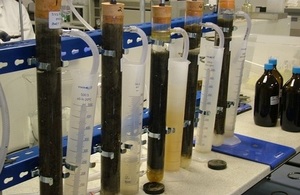Mercury solidification for disposal
Radioactively contaminated mercury could be solidified, enabling it to be successfully disposed of.

Leach testing trials of mercury samples, solidified using the Perma-Fix process
Challenge
Treatment of radioactively contaminated mercury, a ‘problematic’ waste that currently lacks an established waste route.
Solution
Adaption of US treatment to stabilise the liquid Technology: Perma-Fix mobile system.
Benefit
Single affordable process that could be deployed across the UK
Status
Further trials and analysis ongoing
Research organisations
Innovation route
Technology transfer from overseas, delivered via the NDA’s Direct Research Portfolio with technical leadership from Low Level Waste Repository Ltd (LLWR) .
Details
Radioactively contaminated mercury has been produced by the UK’s nuclear industry in relatively small quantities, but, as a toxic liquid waste, is difficult and expensive to deal with.
The hazardous liquid is stored in various locations, with the UK’s largest inventory at Dounreay, where the site’s experimental research activities left a legacy of several tonnes in storage vessels.
Sellafield, Magnox and other non-NDA organisations have smaller quantities making it an issue relevant across the industry. In one of the first attempts to identify a cost-effective, cross-industry solution for the UK, Low Level Waste Repository Ltd (LLWR) in Cumbria, is leading a project funded through he NDA’s Direct Research Portfolio to solidify the mercury using the Perma-Fix chemical treatment process.
Deployed in the US for more than 10 years, mostly with non-radioactive material, the Perma-Fix technology stabilises the mercury through a carefully controlled reaction with sulphur.
Work is now under way to identify the best process for applying the technology. A mercury simulant will be treated, the resulting solids analysed and subject to leach testing. This phase of the work will be carried out by Amec Foster Wheeler. If successful, the material could be disposed of at the LLWR.
Further tests will be carried out on solidified mercury that has been encapsulated in concrete, replicating the standard process for waste disposal at LLWR.
The testing phase will also provide information to establish whether the material meets the disposal criteria for Dounreay Site Restoration Ltd (DSRL) and Radioactive Waste Management (RWM).